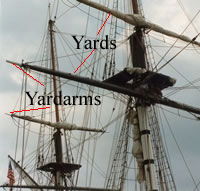
Last night there was some discussion of the phrase ‘when the sun is over the yardarm’ and none of us were sure what a yardarm or even a yard is. I suspected that there were part of the rigging of a sailing ship, but wasn’t sure which part.
I now know that a yard is a spar, or long piece of wood or metal attached to the mast of a sailing ship to which the sails are attached, and that a yardarm is the end of a yard (see photo).
The phrase ‘over the yardarm’ refers to the practise of officers on sailing ships of waiting until the sun appeared to above a particular yardarm before having their lunch or first alcoholic drink of the day. In summer in the north Atlantic this would be at about 11am. This became the time when the sailors received their first ration of rum, and the officers stuck to this time even when ashore. The expression spread to landlubbers and is still quite widely used, especially in North America. On land the sun appears over the proverbial yardarm at around 5pm. It first appeared in print in Rudyard Kipling’s From Sea to Sea in 1899. [from World Wide Words and Wikipedia].
In the ships of Nelson’s navy (i.e. the British navy during the Napoleonic Wars) the timing of meals was dictated by strict tradition. The general sailors ate supper at 12 and dinner at 4pm. Grog (watered rum with lemon juice) was served with these meals and was strictly forbidden at other times – the grog store was one of the areas guarded by armed marines on some ships – except on special occasions. The officers ate supper at 1 and the captain at 2. This was partly because there was only one galley. The the officers generally also drank with meals, though usually wines of various kinds. The officers only drank grog as a last resort, and not outside of meal times as a rule.
The idea that they started drinking when the sun was over the yard-arm might relate to a different time period, but I think the situation I describe has applied since the late 1700s.
“A Sea of Words” reckons that Admiral Vernon (aka “Old Grog”) ordered grog to be served at noon and 6pm in 1740. Though here I think the author is mistaken. There are two “dog” watches – 4-6pm and 6-9pm and dinner was served at the beginning of the first dog watch. Vernon’s orders can be seen here: http://www.pussers.com/t-vernons-orders.aspx He doesn’t mention times, only the practice of watering the rum.
Time aboard ship was regulated by bells each half-hour. The day began at noon – following a sextant sighting of the sun at its zenith if possible. At least by the Napoleonic wars this was standardised across the whole navy.
Even in the North Atlantic the sun rises to different at different times and latitudes.
Also note that the yardarm was where signal flags were flown.
Sources include the 21 novels of Patrick O’Brian which faithfully recreate life aboard a man o’ war (I’ve read them all twice); Blake & Lawrence. The Illustrated Companion to Nelson’s Navy (2005); King, D. A Sea of Words (2000)
The phrase “over the yardarm” predates Kipling by at least a century, though not in the sense of ‘time to have a drink’. However there is an earlier reference: Elmhirst, Edward Pennell. Fox-hound, forest, and prairie. 1892.
So I would say that the phrase is of unknown origin, though obviously a naval saying. A great deal of naval slang was incorporated into English presumably because of pressing land’s men during the Napoleonic wars.
“The general sailors ate supper at 12 and dinner at 4pm.”
Veering off topic a little, but have the terms ‘supper’ and ‘dinner’ exchanged meanings since then? Nowadays, in my experience, ‘supper’ always refers to an evening meal. Usage of ‘dinner’ varies to some extent from region to region in respect of time of day, but tends to imply a sit down meal more than a midday snack. But perhaps nautical usage is different again.
Just wanted to make sure you saw my post, Simon: http://spiritedremix.blogspot.com/2013/01/yardarm-omniglot.html
DJ HawaiianShirt – yes I saw your post – thanks for that.